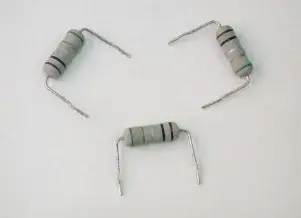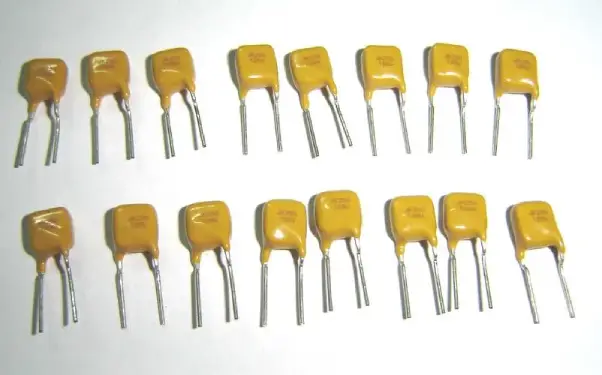

Differences Between a Fuse Resistor and a Fuse
Catalog
Fuse ResistorWhat is the function of a fuse resistor?How to identify a fuse resistor?What are the types of fuse resistors?Applications of fuse resistorsWhat is the basic composition of a fuse?What’s the difference between a fuse resistor and a fuse?Frequently Ask QuestionsRelated ArticlesThis article dives into the key differences between fuse resistors and fuses. By the time you’re done reading, you’ll have a clearer understanding of both and know how to tell them apart and use them effectively. If you’re curious about the basics of how fuses work, their structure, and how to choose one, check out the article The Basics of Fuses: Working Principle, Structure, and Selection Tips.
Fuse Resistor
A fuse resistor works like a regular resistor during normal operation. However, if a fault occurs and the circuit draws more power than it’s rated for, the fuse resistor will disconnect the circuit within a certain timeframe to protect other components. There are two types of fuse resistors: ones that can’t be repaired and ones that can be.

Fuse Resistor
What is the function of a fuse resistor?
Fuse resistors serve two purposes in a circuit: acting as both a resistor and a fuse. They’re most often found in power supply outputs or secondary power supply circuits. Typically, they have low resistance (a few ohms to tens of ohms) and low power ratings (1/8W to 1W). Their main job is to blow (fuse) during an overcurrent situation, protecting other components in the circuit from damage.
In case of a short circuit or overcurrent, the temperature of a fuse resistor can spike to 500–600℃ almost instantly. At this point, the resistor's layer burns out or melts, breaking the circuit and ensuring the safety of the overall system.
How to identify a fuse resistor?
Although fuse resistors are common in power supply circuits, their markings can differ by country or manufacturer. Despite the lack of standardization, you can usually spot them by the following features:
- Unique markings: They look noticeably different from regular resistors in circuit diagrams.
- Specific usage: You’ll often find them in high-current or secondary power supply circuits.
- Single color band: Unlike typical resistors, they usually have just one color band indicating the resistance value.
- Installation style: Fuse resistors are often soldered with longer leads, keeping them elevated from the circuit board. This helps with heat dissipation and makes them easier to recognize.
What are the types of fuse resistors?
Fuse resistors can be divided into non-repeatable and repeatable types, depending on how they operate.
- Non-repeatable fuse resistorsThese look similar to regular metal film resistors. When they experience an overload, the temperature rises, causing their film layer or windings to burn out and break the circuit. Once fused, they cannot be reused; they must be replaced after identifying and fixing the fault.Non-repeatable fuse resistors typically have power ratings of 0.25–3W and resistance values from 0.2Ω to 20kΩ. They can fuse within 1–60 seconds when subjected to 9–25 times their rated power.
- Repeatable fuse resistorsThese are housed in a shell and use low-melting-point solder. When overheated, the solder melts, disconnecting the circuit. After cooling, they can be repaired and reused. They usually have power ratings of 3–12W, resistance values of 1Ω–5.1kΩ, and fuse within tens to hundreds of seconds.
Most modern electronics use non-repeatable fuse resistors, especially wire-wound, carbon film, metal film, oxide film, or chemically precipitated film types. Wire-wound versions are better for high-current applications, while the film types are more common overall.
Applications of fuse resistors
Fuse resistors are widely used in TVs, stereos, VCRs, and computer monitors. For instance, in monitors, they protect low and medium voltage power supply circuits and are usually low resistance (a few ohms to tens of ohms) with small power capacities (1/8W to 1W).
In TVs, fuse resistors protect critical components like picture tube filaments, integrated circuits, larger transistors, and power supply outputs. They’re particularly crucial in large-screen color TVs, safeguarding against potential damage to expensive parts.
2. Fuses

fuse
What is the basic composition of a fuse?
A fuse is made up of three main parts:
- The fuse elementThis is the core part of the fuse, responsible for cutting off the current when it blows. For fuses of the same type and specification, the material, size, and resistance should be consistent, with the resistance as low as possible. The most critical thing is that their fusing characteristics must be reliable and consistent. Household fuses are often made from lead-antimony alloys.
- The electrodesTypically, there are two electrodes that connect the fuse to the circuit. They need to have excellent electrical conductivity and shouldn’t create noticeable contact resistance during installation.
- The fuse holderSince the fuse element is usually thin and soft, the holder’s job is to support and protect it. It helps form a rigid structure for easy installation and use. The holder must have good mechanical strength, insulation, heat resistance, and flame-retardant properties. It should not break, deform, burn, or cause short circuits during operation.
What’s the difference between a fuse resistor and a fuse?
A fuse resistor acts as both a voltage divider and a current limiter. It’s usually connected in series with the load (e.g., an appliance) to prevent it from burning out or causing a short circuit. While it offers protective functions like a fuse, its role focuses more on controlling current flow.
On the other hand, a fuse is a straightforward protection device. Once it blows, it permanently breaks the circuit, and you’ll need to replace it with a new one.
The key distinction is that a fuse completely cuts off the current when it blows, whereas a fuse resistor doesn’t "break" in the same sense. A fuse resistor limits current to prevent short circuits, but its size matters—if it’s too large, it’ll waste power as heat.
What are the different types of leaded resistors?
Leaded resistors come in various types designed for specific applications:
- High Voltage Circuit: Fixed Ceramic - CPCN.
- High Voltage, High Resistance Thick Film: GS.
- Ceramic Resistors for Anti-Pulse Surge: HPC, PCF.
- High Voltage Power Resistors: PSN, PV, PSO, PN, PWW, PAP.
- Anti-Surge Resistors: RCR.
- Metal Glaze Discharge Path Resistors: RK.
Frequently Ask Questions
What’s the difference between a fuse resistor and a normal resistor?
A regular resistor can fail in two ways: it might open up or short out. On the other hand, a fuse resistor is designed to fail only by opening the circuit (like a fuse). In a circuit with both a fuse and a fuse resistor, the fuse is meant to blow first. If the fuse does blow, though, it’s a good idea to check the fuse resistor as well.
What happens when a resistor goes bad?
When a resistor goes bad, it usually becomes an "open circuit." This means its resistance becomes extremely high or it completely breaks, stopping current flow through that part of the circuit. Depending on the resistor's role, this can disrupt the device's normal function. The most common reason for failure is overheating caused by excessive current.
What does a resistor do for beginners?
A resistor limits the amount of current flowing through a circuit. For example, it protects sensitive components, like LEDs, by preventing too much current from damaging them. Without a resistor, components like transistors or integrated circuits could easily burn out.
What wire is used for resistors?
Resistors often use Nichrome wire. This alloy is made of chromium and nickel, sometimes with a bit of iron. The specific mix of materials gives it the desired resistance. Different percentages of these materials help create wires with varying resistivity levels.
What are the different types of fusible resistors?
Fusible resistors, also called current-limiting resistors, fuse resistors, or meltdown resistors, are low-power resistors designed to melt and break the circuit when a specific current threshold is exceeded. This acts as a safeguard, cutting off the circuit to prevent further damage.
Related Articles
Introduction to HDMI Connectors
A Complete Guide to Fiber Optic Connectors
Audio Connectors:Description,Types and Applications
Introduction to Board-to-Board Connectors
Active Optical Connectors: Features, Types, and Applications
FPC/FFC Connectors:Features, Types, and Applications
Subscribe to JMBom Electronics !













